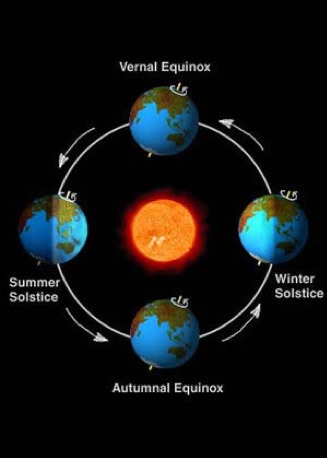Sign up for FlowVella
Sign up with FacebookAlready have an account? Sign in now
By registering you are agreeing to our
Terms of Service
Loading Flow

Seasons
What makes our seasons...?
We have seasons because Earth's axis – the imaginary line that goes through the Earth and around which the Earth spins — is tilted. It's tilted about 23.5 degrees relative to our plane of orbit (the ecliptic) around the Sun. As we orbit our Sun, our axis always points to the same fixed location in space. Our northern axis points almost directly toward Polaris, the North Star.
Spring-
Vernal equinox is when the sun sits directly above the equator on its apparent trip northward. Of course this sun isn’t moving; Earth is. As Earth revolves around the sun, the top half, called the Northern Hemisphere, becomes tilted more toward the sun as winter turns to spring. Meanwhile the bottom half, the Southern Hemisphere, becomes tilted more away from the sun. So it is autumn for people in Australia and the southern parts of Africa and South America. Sunrise and sunset are about twelve hours apart everywhere on Earth. We get medium amount of sunlight.
Summer-
The summer solstice in the Northern Hemisphere, or top half of Earth, is around June 21. That's when the sun reaches its most northern point over our planet. The days around June 20 are the longest of the year, and the rays from the sun beat almost directly down on use and warm us up. You might think that the longest days of the year would be the hottest. But they are not. The hottest weather, on average, comes about a month after the summer solstice. This season gets a lot of sunlight that's why earth is so warm.
Fall-
The changes start with the sun and the earth’s orbit around it. What actually changes is not the distance of the earth to the sun, but the angle of the sun’s rays on the earth. With less and less direct sunlight on the top half, the days here get shorter and temperatures get colder as winter nears. Those shorter days and cooler temperatures act as a signal to the trees and plants around us to get ready for winter. This season also get a medium amount of sunlight.
Winter-
winter is when earth’s north pole is tilted farther away from the sun than at any other time of the year. This is called the winter solstice, and the days just before Christmas are the shortest of all. During this time, the sun shines more directly on the lower half of the earth, or Southern Hemisphere. While we in the United States have winter, Australia, South Africa and the southern parts of South America will have summer. Because the weather continues to cool for about another month after the shortest days, the coldest weather actually arrives after the winter solstice. For most of the Northern Hemisphere, January and February are typically the coldest months. This season doesn't get much sunlight, but gets just enough to let the plants stay alive.
